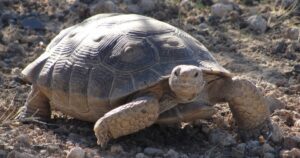Know When to Stick Your Neck Out
Know When to Stick Your Neck Out

Know When to Stick Your Neck Out - Day 482 - Daily Content Challenge
Desert Tortoise are only found in the Mojave Desert in California, Nevada, Arizona and Utah. The desert tortoise has many names. They include Mojave desert tortoise, Agassiz’s desert tortoise, or simply desert tortoise.
Desert tortoises are built to thrive in the desert. They can fully retract their heads and legs inside the shell when disturbed. This protects their softer body parts from predators. Once they reach adulthood desert tortoises are rarely killed by predators.
The desert tortoise’s front legs are slightly flattened. This makes it easy to dig into the desert sand and dirt and to build shelters to keep warm on cold desert nights. They use these burrows to sleep in a light hibernation through the coldest part of winter. If the weather is nice they will emerge. Desert tortoises also use their burrows for temperature control if it gets too hot in the summer.
Desert tortoises can range from nine to 15 inches in length and weigh between eight to 15 pounds. The shell makes up to 30% of its total weight. Males, which can be identified by their curved horns below the neck on the lower shell, are larger than females. Once they reach adulthood, desert tortoises can live 35 to 40 years in the wild. Those in human care can live between 50 to 80 years.
Desert tortoises are herbivores. They dine on grasses, flowers, fruit and cactus. Because these foods contain a lot of moisture, desert tortoises can go for up to a year without access to fresh water!
Tortoises might be slow moving but they spend most of their time hiding in the shade of shrubs and rocks or in their burrows, it is a rare treat to spot one. If you do see a tortoise in the wild, it is important that you do not pick it up. A tortoise will void its bladder if frightened. If it is not able to replenish its water supply, this could have life-threatening consequences for the animal.
Desert tortoises are usually solitary. When males come across each other, they may flip one another over as they fight for dominance. Desert tortoises have been kept as pets in Arizona for many decades. Tortoises are highly personable and appear to interact with people and other animals.
These are the sayings on the bookmark called Advice from a Desert Tortoise.
-
Take it Slow
-
Conserve our Resources
-
Carry Home Wherever You Go
-
Know When to Stick Your Neck Out
-
Escape the Heat
-
Stay Close to the Earth
-
Live Long!
Here are my comments about each of these sayings.
-
Take it Slow - Proceed in a slow, careful, measured way. Do rush into something without a plan.
-
Conserve our Resources - Earth;s natural resources include minerals, plants, soil, water, wildlife and the air we breathe. Conservation is the care and protection of all these resources so they can persist for future generations.
-
Carry Home Wherever You Go - Home is where you feel safe, connected, understood, and loved.
-
Know When to Stick Your Neck Out - If you stick your neck out, it means you are taking a risk. But if you stay in your comfort zone things will never change.
-
Escape the Heat - Find a way to stay cool.
-
Stay Close to the Earth - Be modest and unpretentious. Being described as down-to-earth is a compliment.
-
Live Long! - Enjoy life and live life abundantly!
Have a great day everyone. Know when to stick your neck out.
# living life abundantly # published author # travelling tuesdays
Which piece of advice from the desert tortoise speaks to you? Share your answers in the comments below.



